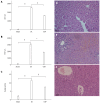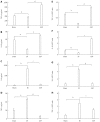Grape seed proanthocyanidin protects liver against ischemia/reperfusion injury by attenuating endoplasmic reticulum stress
- PMID: 26139992
- PMCID: PMC4481441
- DOI: 10.3748/wjg.v21.i24.7468
Grape seed proanthocyanidin protects liver against ischemia/reperfusion injury by attenuating endoplasmic reticulum stress
Abstract
Aim: To explore the effect of grape seed proanthocyanidin (GSP) in liver ischemia/reperfusion (IR) injury and alleviation of endoplasmic reticulum stress.
Methods: Male Sprague-Dawley rats (220-250 g) were divided into three groups, namely, sham, IR, and GSP groups (n = 8 each). A liver IR (70%) model was established and reperfused for 6 h. Prior to reperfusion, the GSP group was administered with GSP (100 mg/kg) for 15 d, and liver histology was then investigated. Serum aminotransferase and inflammatory mediators coupled with superoxide dismutase and methane dicarboxylic aldehyde were detected. Western blot was conducted to analyze the expression of glucose-regulated protein 78, CCAAT/enhancer-binding protein homologous protein, activating transcription factor-4, inositol-requiring enzyme-1, procaspase-12, and nuclear factor-κb. Apoptotic cells were detected by TUNEL staining.
Results: The serum aminotransferase, apoptotic cells, and Suzuki scores decreased in the GSP group compared with the IR group (Ps < 0.05). The methane dicarboxylic aldehyde level was decreased in the GSP group, but the superoxide dismutase level was reversed (Ps < 0.05). Similarly, GSP downregulated the proinflammatory factors and upregulated the levels of anti-inflammatory factors (Ps < 0.05). Western blot data showed that GSP increased glucose-regulated protein 78 expression and suppressed expression of CCAAT/enhancer-binding protein homologous protein, activating transcription factor-4, inositol-requiring enzyme-1, procaspase-12, and nuclear factor-κb compared with the IR group.
Conclusion: GSP possesses antioxidative, anti-inflammatory, and antiapoptotic effects by relieving endoplasmic reticulum stress through regulation of related signaling pathways to protect the liver against IR injury.
Keywords: Anti-apoptosis; Endoplasmic reticulum stress; Grape seed proanthocyanidin; Inflammation; Ischemia/reperfusion injury.
Figures





References
-
- Bagchi D, Bagchi M, Stohs Sj, Ray SD, Sen CK, Preuss HG. Cellular protection with proanthocyanidins derived from grape seeds. Ann N Y Acad Sci. 2002;957:260–270. - PubMed
-
- Bailly-Maitre B, Fondevila C, Kaldas F, Droin N, Luciano F, Ricci JE, Croxton R, Krajewska M, Zapata JM, Kupiec-Weglinski JW, et al. Cytoprotective gene bi-1 is required for intrinsic protection from endoplasmic reticulum stress and ischemia-reperfusion injury. Proc Natl Acad Sci USA. 2006;103:2809–2814. - PMC - PubMed
-
- Liu G, Sun Y, Li Z, Song T, Wang H, Zhang Y, Ge Z. Apoptosis induced by endoplasmic reticulum stress involved in diabetic kidney disease. Biochem Biophys Res Commun. 2008;370:651–656. - PubMed
-
- Schröder M, Kaufman RJ. The mammalian unfolded protein response. Annu Rev Biochem. 2005;74:739–789. - PubMed
Publication types
MeSH terms
Substances
LinkOut - more resources
Full Text Sources
Other Literature Sources
Medical

